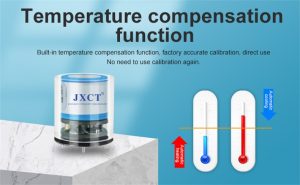Smart cities are the future of urban living, with technology playing a crucial role in making cities more efficient, sustainable, and livable. One of the key challenges that smart cities face is ensuring clean air for their residents. Air pollution is a major public health concern, with the World Health Organization estimating that 91% of the world's population lives in places where air quality exceeds the recommended limits. In this context, gas sensing devices have emerged as a valuable tool for monitoring and managing air quality in smart cities.

Gas sensing devices
also known as gas sensors, are electronic devices that detect and measure the concentration of gases in the air. They are used to monitor a wide range of pollutants, including carbon monoxide, nitrogen dioxide, sulfur dioxide, ozone, and volatile organic compounds. Gas sensors can be deployed in various urban environments, such as streets, public transportation systems, industrial facilities, and residential areas, to provide real-time data on air quality.
The impact of gas sensing devices on smart cities is multifaceted
Firstly, they enable city authorities to collect accurate and up-to-date information on air pollution, which is essential for developing effective air quality management strategies. By analyzing the data collected by gas sensors, city planners can identify pollution hotspots, track the impact of traffic and industrial activities on air quality, and assess the effectiveness of pollution control measures.
Moreover
gas sensing devices empower citizens to take an active role in monitoring and improving air quality. In many smart cities, gas sensors are integrated into mobile applications and online platforms, allowing residents to access real-time air quality data and receive alerts about pollution levels in their vicinity. This not only raises awareness about the impact of air pollution on public health but also encourages individuals to make informed choices, such as choosing less polluted routes for their daily commute or advocating for cleaner energy sources.
Furthermore
gas sensing devices have the potential to revolutionize urban transportation systems. By installing gas sensors in public buses, taxis, and other vehicles, city authorities can gather data on emissions from different types of vehicles and identify opportunities for reducing pollution from the transportation sector. This information can be used to optimize public transportation routes, promote the use of electric and hybrid vehicles, and incentivize eco-friendly driving behaviors.
In addition to their role in air quality monitoring, gas sensing devices contribute to the development of smart infrastructure in cities. For instance, they can be integrated into smart building management systems to regulate indoor air quality and energy consumption. Gas sensors can also be combined with other types of sensors, such as temperature and humidity sensors, to create comprehensive environmental monitoring networks that support sustainable urban development.
However, the widespread adoption of gas sensing devices in smart cities is not without challenges. One of the main obstacles is the cost of deploying and maintaining a large number of sensors across urban areas. While the prices of gas sensors have been decreasing in recent years, the scale of deployment required for comprehensive air quality monitoring in smart cities still represents a significant investment for city authorities.
Another challenge is the need for standardized data collection and analysis protocols. With multiple stakeholders involved in air quality monitoring, including government agencies, research institutions, and private companies, there is a risk of fragmentation and inconsistency in the data collected by gas sensors. To address this issue, efforts are underway to develop common standards for sensor calibration, data transmission, and data interpretation, in order to ensure the reliability and comparability of air quality data from different sources.
Furthermore, the integration of gas sensing devices into smart city infrastructure raises concerns about data privacy and security. As gas sensors collect and transmit sensitive information about the environment and human activities, it is essential to establish robust data protection measures to safeguard the confidentiality and integrity of the data. This includes implementing encryption protocols, access controls, and data anonymization techniques to prevent unauthorized access and misuse of air quality data.

Despite these challenges, the potential benefits of gas sensing devices for smart cities and clean air are undeniable. As cities around the world continue to embrace the concept of smart urban development, the demand for innovative solutions to address air pollution is growing. Gas sensing devices offer a practical and cost-effective means of monitoring air quality, engaging citizens in environmental stewardship, and optimizing urban infrastructure for sustainable living.
In conclusion, gas sensing devices have a significant impact on smart cities and clean air by providing real-time data on air quality, empowering citizens to make informed choices, and supporting the development of sustainable urban infrastructure. While there are challenges to overcome in terms of cost, standardization, and data security, the potential benefits of gas sensors for smart cities are driving ongoing research and innovation in the field of environmental monitoring technology. As smart cities continue to evolve, gas sensing devices will play a critical role in ensuring a healthier and more sustainable urban environment for all.
 : +86 155 8830 2704
: +86 155 8830 2704 : jxdziot@gmail.com
: jxdziot@gmail.com
